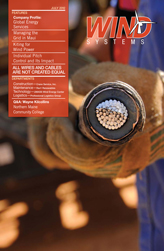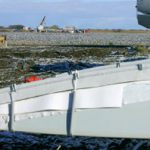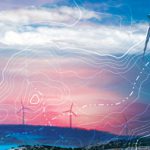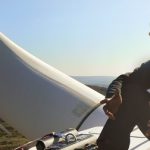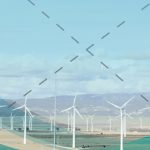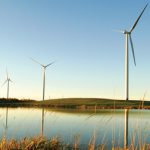Overlooking the scenic shores on a ridgeline in the West Maui Mountains, First Wind’s Kaheawa Wind Project is helping Hawai’i Clean Energy Initiative realize its goal to provide at least 70 percent of the power from clean energy sources by 2030.
“This is the second phase of a project on a very small island electric system where this wind project is quite large in proportion to the size of the electric system versus a similar site on mainland United States,” said Tom Siegel, vice president of Transmission for First Wind. “The challenge for us was the variability of wind power. It can significantly impact the reliability of the power system. As the wind increases or decreases along the trade wind path, operational frequency is affected.”
Initial studies for the project by the Maui Electric Company (MECO) asked how much energy could be taken by the utility without upsetting the balance of current electrical output, customer needs, and how a wind farm would impact the utility’s status with regulatory boards. The amount of energy could be supplied through wind energy were relatively low, so it was determined that the island and MECO could work in harmony if a 30 megawatt wind farm was constructed and connected to the grid.
The first phase known as Kaheawa Wind Project I (KWPI) was completed June 2006 and now KWPII, a 21 megawatt site is due for completion in the next few months.
“The first phase is the wind turbines, substation and operations support facilities, but has no energy storage system,” Siegel said. “Phase II includes 14 wind turbines rated at 1.5 megawatts for a total of 21 megawatts of wind energy. Phase II also includes the substation, integrated energy storage, and offices and facilities to monitor and maintain our integrated power system.”
KWPI provided First Wind the opportunity to learn how the island and wind energy would exist together, and because the systems are small, curtailing the resources was necessary to maintain the reliability of the MECO electric system. Figure 1
“People often talk about wind generation in terms of the average capacity factor. The Kaheawa wind project has an average capacity of 40 to 45 percent,” Siegel said. “The Kaheawa wind project provides about nine to 10 percent of all energy consumed on the island curtailing the energy was a concern for the Maui utility company who contracted us.”
Since curtailment was paramount to the success of both the KWPI and KWPII projects, First Wind had to manage the system frequency, transmission rates and also store energy for later use.
“When you add up the amount of utility-owned generation that has to be online and compare that to customer demand, there is often not enough of a difference to allow the utility to take all of the wind energy generation that’s available, so you curtail or back down and that’s where storage comes into play,” Siegel said. “Combining wind and energy storage give us the ability to store energy for use at a later time. We sought a way to smooth out moment-to-moment variability when the wind is gusting strongly or suddenly drops off. We needed a storage system and that’s how Xtreme Power’s system became involved,” he said. “The advantage of the energy storage system is it allows us to smooth out the variable wind generation and gives the utility company more time to make the decision of whether or not to start a generator when the wind generation drops unexpectedly.” Figure 2
This situation in Kaheawa was a significant concern for the local island utility provider, but investigational studies showed that by the electrical provider with continuous status updates on turbines, and substation and the energy storage system, it would be possible to deliver more renewable energy to a community eager to remain eco-friendly.
“As a wind farm developer, we had to ask ‘do we have the ability to control the energy we provide to Maui’s grid?’” Siegel said. “We found the Xtreme Power energy storage system was the right solution for the situation we faced.”
The solution for First Wind and Kaheawa was an alternative energy system that maximizes the winds on the island’s grid with a technology that integrates power management and energy storage into an intelligent package. Figure 3
“We found that DPR was the right solution in this instance,” he said. “It helps us meet stringent performance requirements and supply more energy to the residents of Maui than would have been possible without the energy storage.”
Providing integrated power management and energy storage for KPWII was a natural fit for both companies since they had already worked on the first Maui project in 2008.
“MPWI was our first renewable integrated site where they took wind turbines and one of our Dynamic Power Resource (DPR) systems and put them together in order to smooth the wind and match it to the grid,” said Alan Gotcher, president and CEO of Xtreme Power.
In Maui, Xtreme Power provided a 10 MW/20 MWh DPR to manage the renewable energy penetration rate increases where the likelihood of curtailment is higher. By combining the Dynamic Power Resource for the 10-megawatt / 20 megawatt hour facility, the DPR stores excess power during curtailment periods and delivers the power to the grid when MECO needs more energy. Figure 4
“Our system works with First Wind’s turbines to provide ramp control, frequency and voltage services, curtailment capture, and responsive reserves to help our customer, First Wind, make more money in its operation,” Gotcher said.
With ramp rate control through the DPR, the wind farm and the utility provider are able to smooth the wind to accommodate for wind variability so that it becomes much less of an issue.
“As an example, MECO might say ‘I need to count on you to control the rate of change or ramp and it can’t vary by more than one megawatt per minute up or down,” Gotcher said. “We do this through software controls or energy in the battery and we are able to add or subtract power relative to what the wind farm is capturing through our Dynamic Power Resource.” Figure 5
When the wind park generates too much energy, MECO and operators are able to ‘feather’ the blade props so they spin slower and capture less energy in the curtailment phase. Any excess energy is stored in batteries on site and used at a later date when usage is higher.
DPR also incorporates a semi-responsive reserve capacity that turns on the alternating current when demand is high. Because this 10 MVA system has a dynamic range of 20 megawatts, the DPR can push or pull 10 megawatts of energy as needed.
When the wind is highly intermittent, the intelligent controls command the DPR to charge or discharge to smooth the power to the utility. If the wind ceases, the utility can command the storage system via Automatic Generator Control (AGC) to discharge electricity to the grid while the generator is coming online. Figure 6
“Our system has several building blocks,” Gotcher said. “Sometimes it is mounted in shipping containers that are 40-feet-long and situated at the base of the turbine or solar park. Sometimes it’s a smaller box. It depends on the numbers of turbines. It consists of a gray box of one IGBT’s with a silicon base with switches for high power demands. The system handles the power to the grid from the batteries and manages real and reactive power for AC that connects to transformers which step up the voltage to as much as 35,000 volts where the utility service takes the power.”
The purple box inside the main system is the master controller for the converter, which visually pushes data to the company’s site in Texas where technicians working 24/7 can control and monitor data lines from the farm to the utility provider as needed.
The DPR is bi-directional and can function in increments of five minutes, 15 minutes, 30 minutes, one hour, four hours or six hours depending on the energy needs in a particular location.
“The battery size is dependent on the duration of the energy cycle and we use copper bussing bars in sizes from 1-2 inches thick; 2-3 inches thick; and up to 2 to 3 feet long,” he said. “So the system acts like three components with energy storage, chemistry, power, an electronic system controller and software in one. Dynamic means we can do all of this quickly; Power is how the industry looks at the output; and Resources is to complement other things we manage. That’s DPR or Dynamic Power Resource.”
By managing the wind with the existing power grid using a system that offers curtailment capabilities, First Wind, MECO and Xtreme Power can provide a regulated amount of power at a given time, while still achieving a high return on the energy generated and sold to customers in an effective way.
“Our first project using DPR was in 2006 at the South Pole,” Gotcher said. “Of course that was in a remote location and we installed a DPR to a diesel powered generator to operate a radio telescope that is 20 feet in diameter. The telescope must rotate every minute to capture a signal, so the challenge was how to use our Dynamic Power Resource to rotate the telescope to generate power at regular intervals and then store the power during breaks. We do an alternating break and regeneration with capture so the break generates less power and stores the energy for later use. It does three million cycles per year and it pushes and pulls power as needed based on the available energy.”
Xtreme’s DPR is installed in 12 sites around the world with eight customers and 26 more projects in the works, and Gotcher speculates on how his company might generate more business as the industry evolves.
Siegel adds that his role with First Wind is making sure each wind farm interconnects and integrates to the existing power grid where he and his employees coordinate with each utility company to solve individual needs. “We have projects in Maine, Vermont, New York, Utah, Washington, and Hawaii and no project is the same.”
For more information on First Wind, visit www.firstwind.com. For more information on Xtreme Power, visit www.xtremepower.com.



















